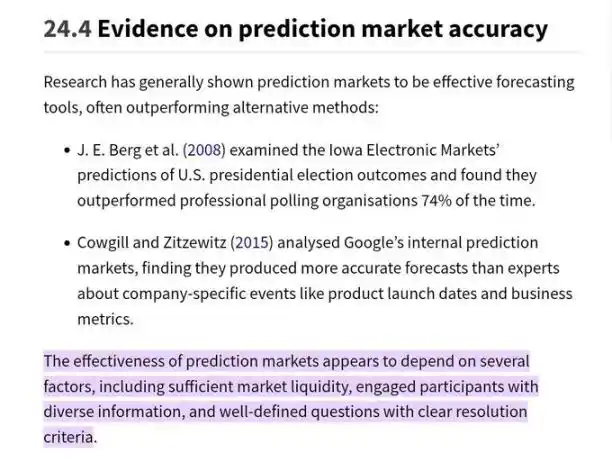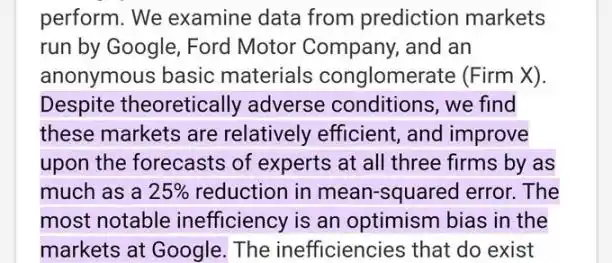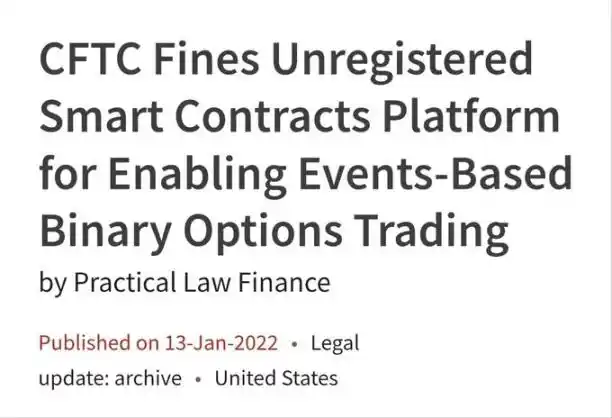Original Title: How to Gauge if a Prediction Market Is Worth It
Original Author: Marvellous
Original Translation: AididiaoJP, Foresight News
Introduction:
Prediction markets are trading platforms where participants bet on the outcomes of future events, becoming increasingly popular in the cryptocurrency and financial sectors.
However, not all prediction markets are the same. Determining whether a specific platform is "worth" your time or money depends on a comprehensive consideration of the following three key factors:
· Its market design
· Economic environment
· User-related factors
These factors are crucial in determining whether a prediction market can provide accurate predictions, sufficient liquidity, and a trustworthy trading experience.
Market Design: Structure, Mechanisms, and Clarity
The concept of market design explores the structure and operation of prediction markets, including trading mechanisms, contract rules, and outcome determination methods. A good design must align incentives and ensure smooth market operation:
Trading Mechanisms:
Prediction markets use different mechanisms to match trades. Some, like @Polymarket and @Kalshi, use order books, while others, like @ZeitgeistPM, use automated market maker models, such as LMSR.
Model Overview:
· Order Book: Efficient under high liquidity but performs poorly in illiquid markets.
· Constant Product Market Maker (CPMM, x*y=k): Simple but has high slippage in extreme cases.
· Logarithmic Market Scoring Rule (LMSR): Limited losses and probability normalization but sensitive to parameters.
· Dynamic LMSR (DLMSR) or pm-AMM: A new model addressing liquidity and slippage issues.
Contract Types and Clarity:
A well-designed market must have clearly defined contracts and outcome determination standards. Contracts are typically binary options (yes/no outcomes, paying $1 if the event occurs) but can also be multi-outcome or scalar contracts (payments vary based on numerical results).
Note: The questions for betting must be clear and the outcomes verifiable. Research indicates that "questions with clear determination standards and definitions" are key factors for effective prediction markets.

This is because if the market questions are vague or the outcomes subjective, traders will lack confidence, fearing their bets will not be fairly adjudicated.
Outcome Determination and Oracles:
Design must ensure that people trust the method of outcome determination. Therefore, traditional prediction markets rely on platform operators or third parties to announce results and pay out prizes, while prediction markets in the crypto space use oracles to input real-world results into smart contracts.
For example, @Polymarket utilizes @UMAprotocol to provide real-world data for market determination.
A robust adjudication mechanism can prevent disputes and manipulation, thereby maintaining market integrity. Therefore, when evaluating a platform, consider:
· Does it have reliable oracles or arbitrators?
· Is there a potential for disputes? If so, how are they handled?
Fees and Technical Design:
High trading costs or slow systems can stifle a platform's usability.
Recall early decentralized markets, such as Augur (launched in 2018 as a pioneer on Ethereum), where users faced high gas fees, low liquidity, and poor user experience, hindering mainstream attention.
Thus, you should consider which chain the product is deployed on, for example, @GroovyMarket_ launched on @SeiNetwork, @Polymarket on @0xPolygon, and @triadfi on @solana.
The platforms I mentioned share a commonality: the chains they are built on ensure lower transaction fees and faster transaction speeds.
Additionally, they simplify the user interface. For instance, Polymarket is built on Polygon (an Ethereum sidechain) and uses USD stablecoins for trading, providing a fast and stable trading experience without exposing users to volatile cryptocurrency prices. It also charges 0% trading fees, making transactions frictionless. Such design choices significantly enhance usability compared to first-generation platforms.
Moreover, you need to assess the fees charged by these platforms (market creation fees, trading fees, deposit/withdrawal fees, profit fees, etc.).
In summary, if a prediction market's design can provide a clear and fair structure: an efficient trading mechanism with sufficient liquidity supply, transparent rules, and trustworthy outcome determination, then it is worth it.
Poor design (slow trading, unclear rules, or untrustworthy outcomes) may be directly rejected by the market.
Economic Factors: Liquidity, Pricing, and Incentives
I believe that every excellent design requires an economic model to succeed, as key economic factors will determine whether a prediction market can effectively aggregate information and reward participants accordingly.
Liquidity and Market Depth:
The concept of liquidity explains the need for sufficient active trading and capital in the market so that traders can buy and sell at fair prices without significant slippage.
For a long time, sufficient liquidity has been an absolutely critical consideration.
Research shows that the effectiveness of prediction markets depends on "sufficient market liquidity" and a large number of traders. If only a few people are trading, prices may fluctuate wildly or stagnate, failing to reflect true probabilities. Therefore, a balance must be achieved.
Look for platforms with high trading volumes or liquidity pools. For example, Polymarket has become the largest decentralized prediction market, accounting for about 94% of total market trading volume in 2024, handling over $8.4 billion in bets, despite new challengers emerging this year.

Such enormous liquidity (especially during major events like the U.S. elections) means that its odds are supported by sufficient market depth, making it harder for any single user to manipulate prices.
Accurate Pricing (Information Aggregation):
The core idea of prediction markets is that market prices reveal the collective beliefs of the crowd regarding the probabilities of events. Therefore, when the economic mechanisms are sound, meaning many informed traders with capital are participating, market prices become very accurate predictions.
In fact, well-functioning markets outperform opinion polls. Recall:
· The Iowa Electronic Market's election predictions beat professional polling firms 74% of the time.

· Google's internal prediction markets made more accurate predictions than company experts.

However, if market liquidity is insufficient or dominated by uninformed bets, prices may be less reliable.
Therefore, always consider the platform's track record:
· Does the platform have examples where its odds correctly predicted outcomes when other predictors failed?
Notably, during the 2024 U.S. elections, Polymarket's odds were closely monitored and even outperformed traditional polls, attracting attention from figures like Elon Musk. This is an important area to consider.
Incentive Alignment:
Economic design should also cover how traders are rewarded and the costs of participation. Low or zero fees are a significant advantage, as high fees can hinder frequent trading or arbitrage, which help maintain price accuracy.
Platforms like Polymarket do not charge trading fees, and some other markets even subsidize participation through token rewards or profits. Additionally, some markets can reward information discovery, such as offering prizes or reputation to the best predictors to encourage knowledgeable participants.
A healthy prediction market economy will make it profitable for traders to correct mispriced odds, so attempts to manipulate prices are often self-correcting. For example, if someone bets irrationally, others have the economic incentive to take the opposite position, pushing the price back to rational levels. If a market is very small, wealthy manipulators may temporarily influence the odds, so scale becomes important again.
Risks and Regulatory Costs:
Another economic consideration is the risks involved, not just the risk of losing a bet but also counterparty risk and regulatory risk. In crypto prediction markets, the security of smart contracts is crucial (as funds are held by code).
On centralized platforms, you rely on the company's solvency and integrity.
Note that regulatory crackdowns can bring costs at any time. For example, Polymarket had to geo-block U.S. users after reaching a settlement with the Commodity Futures Trading Commission (CFTC) (fined $1.4 million) due to its operation of unregulated event markets.

During the period when U.S. users were excluded, liquidity on certain markets reportedly declined. Similarly, some countries completely ban prediction markets.
By the end of 2024, France, Singapore, and Thailand had all blocked access to Polymarket. In fact, these factors can economically impact a platform (reducing its user base or forcing compliance costs).
Therefore, a "worthwhile" market should have a stable legal foundation or contingency plan. Otherwise, participants will face sudden closure or unfulfilled economic risks.
Essentially, the economics of prediction markets must ensure sufficient stakeholders and smooth transactions. The best markets will have ample participation, low trading costs, and mechanisms that incentivize accurate predictions.
User and Community Factors: Engagement, Trust, and Experience
Regardless, I like to consider user-related factors, which are essentially the human side of the market, as the effectiveness of prediction markets depends on their users and the surrounding community.
Therefore, key points to assess include:
Scale of Participation:
Prediction markets rely on scale. The more individuals participate, the more effective they become. A large and active user base means diverse information and perspectives are brought to the table.
Diversity of Opinions is Crucial
If all traders share the same views (or collude), the market cannot aggregate independent information. Therefore, it is important to focus on the following metrics:
· Number of active users
· Amount wagered
· Open contracts, etc.
Overall, a platform with thousands of actively participating traders is far more robust than one with only a few users. Active participants with diverse informational backgrounds are one of the key driving forces behind the accuracy of prediction markets.
For example, Augur is fully decentralized, but its early version had very few active users, which, despite its innovative technology, limited its effectiveness.
In contrast, Polymarket gained critical mass by providing markets on popular topics (elections, sports, cryptocurrency prices) and making entry easy (no KYC globally, simple web interface). This scale of participation greatly enhances the "wisdom of the crowd" effect.
User Experience and Accessibility:
Even for crypto-native users, user experience is important. Platforms that are overly complex or require complicated wallet setups can scare users away.
Focus on emerging prediction markets that emphasize a smooth onboarding experience, as a clean interface, useful charts, and clear odds presentation will attract more users, which in turn improves market quality.
On the other hand, cumbersome processes (e.g., needing to manually acquire and stake specific tokens to place bets, or long waits required for transaction finality) may lead traders to feel that the market is not worth the effort to participate.
Therefore, always consider the ease of use of a platform.
· Can you easily deposit funds?
· Does it support mobile devices?
· Is there customer support or community help if issues arise?
Reputation and Community Trust:
Since real money is involved, trust is crucial. Trust can come from transparency (open-source code, audited contracts, or reputable backers) or from a record of fair operation.
Therefore, check if the platform has had any scandals or failures to pay. Community-operated and decentralized markets like Polymarket seem to be trustless, while other markets like Kalshi build trust through full regulation and compliance, as we saw in 2024 when Kalshi became the first CFTC-regulated exchange in the U.S. to offer legal event contracts, even winning a lawsuit to provide election betting.
This regulatory recognition lends credibility and signals to users that they can trust the platform to operate within legal boundaries.
At the same time, platforms operating in gray areas are a red flag. You are either decentralized with audited code, or you are fully regulated.
User Incentives and Behavior:
Another human factor is the reasons for user participation. Are they casual gamblers, profit-seeking traders, or domain experts hedging risks? I believe that markets with a strong community of predictors may yield better insights.
The culture of a platform, whether it leans more towards a gambling atmosphere or a serious predictive tool, will influence whether it suits your purposes. When deciding if a prediction market is worth using, assess the community:
· Is it active and serious?
· Do they have opposing viewpoints?
The presence of "active participants with diverse information" is one of the key factors for the success of prediction markets.
I believe a constructive community will support meaningful markets that can accurately determine outcomes, while a poorly managed community may wallow in poorly defined markets.
In summary, user factors boil down to the quantity and quality of participants. Therefore, a platform with a large, diverse, and actively participating user base that has earned their trust is more likely to provide a valuable experience.
If a market has almost no users or community, regardless of the technology behind it, you might want to steer clear. After all, prediction markets are a form of crowdsourcing, which means without a "crowd," there is nothing to participate in.
Final Summary:
When evaluating a prediction market, always return to the three core considerations:
· Market Design
· Economic Viability
· User Factors
A platform with sound mechanisms, sufficient liquidity, and a vibrant, trustworthy community is more likely to provide value in terms of profitable trading opportunities and accurate predictions.
免责声明:本文章仅代表作者个人观点,不代表本平台的立场和观点。本文章仅供信息分享,不构成对任何人的任何投资建议。用户与作者之间的任何争议,与本平台无关。如网页中刊载的文章或图片涉及侵权,请提供相关的权利证明和身份证明发送邮件到support@aicoin.com,本平台相关工作人员将会进行核查。




